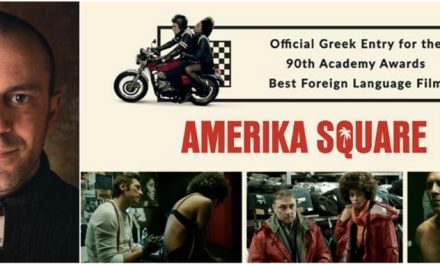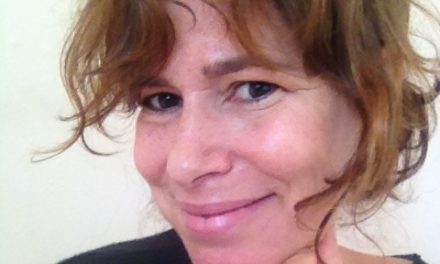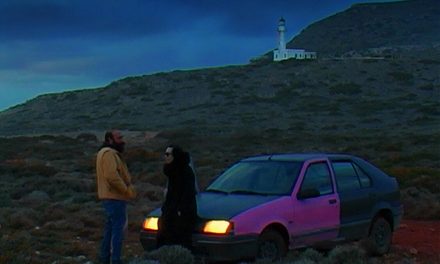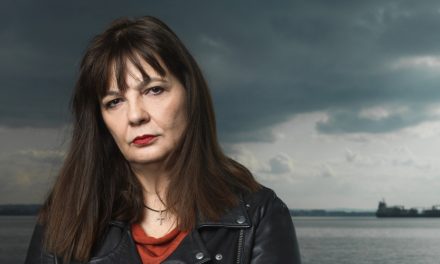Minos Nikolakakis’ first feature film “Entwined”/ “Alyti” is a modern fairy tale inspired by Greek and Balkan myths. Panos, a young doctor goes to work at a remote Greek village, where he will meet Danae, a young woman with a rare disease that gradually makes her her skin resemble tree bark. Danae lives in the forest, isolated from the superstitious villagers. As Panos falls for her and wants to help her out of the woods, he will get into a state that will be difficult, if not impossible, to disentagle.
Born in Athens in 1980, director, scriptwriter and producer Minos Nikolalkakis holds a master’s degree in civil engineering from the University of Patras. His short films “The Attic” (2012), “Happy Life” (2009), “Marionette” (2007), “The Present” (2005) and “Ticket to Ride” (2003) were screened at many international festivals (including LA Shorts Fest, CINEMED Montpellier, Uppsala και Flickers Fest). “Entwined”premiered in 44th Toronto IFF, screened in 35th Warsaw IFF, 60th Thessaloniki International Film Fetsival and 50th IFF India/Goa. In his interview* with Greek News Agenda Nikolakakis explains how he infused elements of Greek and Balkan tradition in a film that flows between fantasy and horror. Nikolalkakis also elaborates on how he implemented special effects and make up so as to serve a neo fairy story in a realistic context.
Your protagonists Danae and Panos represent two opposite worlds: science and logic versus paganism and nature. What happens when they meet? Is love devouring?
What happens is what occurs when two different worlds meet. They fail to understand and accept each other’s view on things. Throughout, they each try to convince the other party that their view is the right one. What we are trying to say with the film is that maybe some times, someone might step aside from her/his safety zone and look at the world in a slightly different way. They might find something that they were ignoring all along. After all, these worlds complete each other. Love, like all things that we are experiencing, is indeed devouring up to a point. It consumes but at the same time it makes us blossom, so there is never a definite outcome. It is not an ideal and romantic situation, but a vivid process with its high and low moments, and this is something we tried to portray in our film.
Your film consists of elements of folk tale and erotic thriller. How did you work on the script and how did you compose your influences?
Along with my writing partner John de Holland, we worked on the idea over the course of two years, back and forth through skype. The idea behind the film germinated in my mind while living up in a secluded Cretan village. Memories of villagers’ everyday behavior regarding superstitions have firmly embedded themselves in my memory. Moreover, stories told by my grandmother where far from usual bedtime fairytales; it was the “legacy” of her ancestors, who were “people of the land” and this was their own perception of the world around them. Growing up, my influences came to be from “paraloges” (type of Greek folk songs), the Victorian Gothic and the work of Edgar Allan Poe, but also the spiritual fables of Lafcadio Hearn. Despite their different origin, there seemed to be a thematic connection. In combination with my love for films like Masaki Kobayashi’s “Kwaidan” and Kaneto Shindo’s “Onibaba”, my intention was to craft a film infused by folk myth with a local feel.
The female protagonist is an ambivalent and ever changing figure. What is her function in the film?
Answering that is tricky, as it might give away important plot points. What I can share is that she is closely connected to nature and the old ways, bearing many secrets of ancient wisdom. Within the relationship she forms with the male character she functions as a catalyst for him to re-experience the world through a new set of eyes and eventually change (in many ways). There are a lot of things that we didn’t answer in this relationship, and within this context we leave room for the audience to choose which opinion they are rooting for and what stand to take every step of the way. So in a sense, the female character is challenging her partner and the viewer as well in order to find their own truth within themselves.
“Entwined” was awarded in Thessaloniki IFF for best location. How did you incorporate the beauty of Parnonas mountain in the film plot?
While writing the screenplay I thought that Greek cinema had ‘stayed indoors’ for quite some time. We scouted many locations during a 6-month period and eventually ended up in Parnonas, and a beautiful village called Kosmas, surrounded by the most unique chestnut-tree forest. With the aid of the locals and especially Nikos Latsis (who happens to be the best location scouter – a shepherd) we found unique spots. Shooting there for a course of 30 days in April-May’s 2018 was a tough call, mainly because of changing weather conditions, tough access, wandering animals etc etc. The forest hammered us to our knees before allowing us to eventually capture her beauty. Filming was done in great fashion by our cinematographer Thodoros Mihopoulos, who made bold and creative calls by crafting an intimidating forest, avoiding the usual “photogenic” look that feels like a commercial, which we experience in the majority of films nowadays. The forest’s blossoming beauty was there, we just had to be smart and practical on how we would capture it.
The film is in this year’s Iris awards nominees for best make up and special effects. In what way did you use these two elements to tell your story?
In “Entwined” we have a big number of different types of special effects, ones that you rarely find in a Greek film, even ones with a big budget. The most difficult one (in universal cinema) is the ageing of a character throughout various stages. This was done by special make-up effects wizard Prokopis Vlaseros (using latex and complicated facial prosthetics) in combination with talented make-up artist Ioanna Symeonidi who crafted the progress of earlier stages. We also have the weird skin condition of the protagonist (done by Prokopis) and complicated digital transformations by Konstantinos Koutsoliotas (Melancholy Star) involving digital animation and composition which is in itself a time consuming and delicate procedure. We also have VFX that make the forest look like a vivid surrounding and digital painting on a village in order to appear decrepit, done by Nikos Pittas (KENT). If you include various makeup needs like cuts, bruises, old extras and looks of sickness, we had our hands full during preproduction, production and post. The hardest part was to achieve these effects to be believable and real rather than impressive. Trying to a make a “grounded to reality” film, we were opting for a result that would take the viewer on a journey in a world that they can relate to as everyday life, rather than an extravagant trip in fantasy land.
What were the difficulties of funding your project and is your next one?
Funding the project of a first time director is always a very difficult and time consuming procedure, since there are limited credentials to claim funds. The difficulty is bigger when it is a Greek project that revolves around a fantasy theme, since Greece doesn’t have tradition in similar films. I am grateful that our main co-producers (GFC, ERT SA, COSMOTE TV) saw behind the genre elements and into the human story, also relating to themes of cultural heritage. It was a 4-year struggle to fund “Entwined” (also researching coproduction options with France, Serbia and Bulgaria) following 3 years of active development in prestigious screenwriting programs. As for the next project, it is in early development and combines elements of surrealism/horror/comedy. We will see to what sort of story it will transform to over the next year and how the industry will shape up by then in order to support such a film.
* Interview by Florentia Kiortsi
Read also: filmint., TIFF 2019 and Cineuropa reviews and Minos Nikolakakis’interview with Cineuropa.













